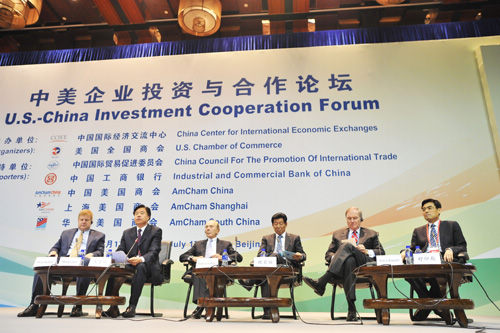|
 |
|
KEYNOTE SPEECH: Panelists talk about Chinese and U.S. investment climates at the U.S.-China Investment Cooperation Forum in Beijing on July 17 (WEI YAO) |
For China and the United States, two-way investment is disproportionately tiny given the size of both economies.
Increasing China-U.S. investment, especially Chinese investment in the United States, will give a strong boost to both countries, especially when the U.S. recovery remains weak and the Chinese economy begins to slow down. More importantly, it will help the world economy recover.
At the U.S.-China Investment Cooperation Forum co-hosted by the China Center for International Economic Exchanges (CCIEE) and the U.S. Chamber of Commerce in Beijing on July 17, officials and business leaders from both countries explored ways to boost two-way investment between the two largest economies.
Small in scale
Increased two-way investment has already promoted economic growth and created jobs in both countries.
The United States has been a major foreign investor in the Chinese market for the past 30 years. According to China's Ministry of Commerce, as of the end of 2011, U.S. investors had set up more than 61,000 companies in China, with paid-in foreign direct investment (FDI) of $67.6 billion, while Chinese companies' direct investment in the United States only totaled $6 billion.
"U.S. investment in China accounts for a small proportion, less than 10 percent, of China's total FDI and China's investment in the United States is even less than that of some small economies, both of which do not match their respective economic size," said Zeng Peiyan, Chairman of CCIEE, a top think tank in China.
Chinese investment in the U.S. market is growing at a rate of about 200 percent a year, said Thomas J. Donohue, President and CEO of the U.S. Chamber of Commerce. "But of $2.3 trillion in FDI in the United States, only 1 percent flows from China," he said.
The proportion of U.S. investment in China is even smaller compared with U.S. total outbound investment. According to Ma Xiuhong, Chairwoman of China Foreign Trade Center and former Vice Minister of Commerce, in 2010, U.S. investment in China accounted for just 0.6 percent of U.S. investments abroad.
The blame for insufficient two-way investment rests on both sides.
U.S. investors appeal to China for access to the service sectors and protection of intellectual property rights, said Zeng.
Chinese companies are not as competitive as their U.S. counterparts in terms of talent, technology, management and marketing, and they lack necessary knowledge of the U.S. political, economic, legal and cultural landscape, he said.
Moreover, some industries in the United States are not fully open to Chinese investors, especially public utilities and infrastructure. U.S. restrictions on technology exports, the safety review of the Committee on Foreign Investment in the United States and the complicated review procedures largely impede Chinese investors.
Removing obstacles
Charlene Barshefsky, senior international partner at WilmerHale in Washington, D.C. and former U.S. trade representative, said that governments and companies of both sides sometimes shoot themselves in the foot.
China needs to resolve problems like capital controls, a slow approval process and occasional lack of financing to the private sector. The United States should solve problems like suspicion of Chinese state-owned enterprises and misunderstanding of Chinese investors' intentions, said Barshefsky.
Companies also create problems for themselves, she said. U.S. companies that come to China are surprised by a lack of transparency or a complicated nature of dealing with government approvals. Chinese companies that come to the United States are surprised by a highly legalistic environment and a requirement for business transparency.
| 